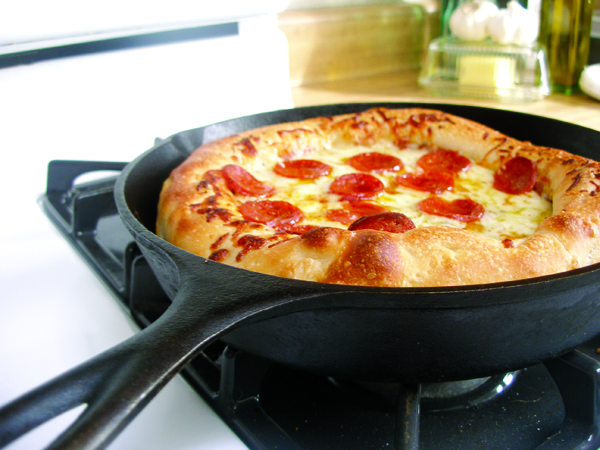 Why a cast iron skillet is all you’ll ever need
Why a cast iron skillet is all you’ll ever need
Several years ago, I moved into an old house in Madison, WI and found a cast iron skillet in the basement. Raised by Teflon lovers, I was wary. It took a graybeard neighbor—a kind of cast iron prophet—to convince me I should try it. “You won’t get Teflon flakes in your food. They’re carcinogenic, you know,” he said, stoking his wood stove. “Plus, stuff just tastes better cooked in cast iron.” Converted, I ran home, scrubbed the skillet down with steel wool and fried up some kielbasa and potatoes. Damn if the graybeard wasn’t right. Dinner tasted fantastic; the kielbasa browned perfectly and the potatoes were crispy. Later, I learned that cooking with cast iron boosts the iron in your diet and the skillet became my one true pot.
Now, I live in a drafty Fishtown rowhome with my beau, and to stay warm we cook like fiends. The cast iron skillet comes in handy three meals a day and at night it doubles as a bed warmer—just heat it, wrap it in towels and tuck it between the covers at the foot of your bed. Feeling the skillet by my feet in the morning reminds me to make a Dutch Baby, a one-dish pancake that puffs up in the oven like a soufflé (and tastes like manna, served with sliced bananas, syrup and toasted walnuts). For lunch, I’m partial to skillet-grilled brie and fig jam sandwiches, or quick cornbread and soup. A skillet-baked chicken makes for an easy supper, although I’ve made a new discovery: skillet pizza. The crust snaps like it’s been made with a pizza stone.
If you’ve never used cast iron before, here are a few tips: Don’t use soap. Scrape off baked-on foods with a wooden scraper, then rinse the pan with warm water and dry it well to prevent rust. To maintain cast iron, rub it down with some vegetable or mineral oil every few days, or if you notice that the surface lacks luster. When you’re ready to fry, use medium heat and add the oil when the skillet’s surface looks shiny. Prowl around at yard sales if you’re in the market for your first skillet, or pick up a pre-seasoned pan at Foster’s Homeware (399 Market St.) or Fante’s (1006 S. Ninth St.) in the Italian Market. Then fry up some potatoes, or better yet, make an oven-pancake supper, and you’ll wonder how you ever made it through a winter skillet-less.
Skillet Pizza:
pizza dough
(enough for two 12-inch skillet pies)
pizza sauce or pesto
olive oil
toppings (try pepperoni, black olives, mushrooms, purple onion)
cheese (a combination of mozzarella,
parmesan and cheddar is nice)
The key to a crisp skillet pizza is heating the pan before you add the dough, and cooking the crust for about 15 minutes before you add the toppings; otherwise, your pizza will be doughy. When your dough is ready, place the skillet in your oven and preheat the oven to 450˚F. When the skillet is hot, coat it with olive oil, and press flattened dough into pan. Gently puncture the dough with a fork to prevent air bubbles, then bake for about 15 minutes, or until golden. Add sauce, toppings and cheese, then lower the heat to 350˚F and return the skillet to oven for 10–15 minutes.
Grilled Brie and Fig Jam Sandwiches With Caramelized Onions:
1 medium onion, sliced
pinch salt
2 tbs. olive oil
1 tbsp. brown sugar
1 tbsp. balsamic vinegar
½ tsp. rosemary
2 tbsp. butter
good bread (crusty sourdough works well)
brie
fig preserves (or chutney)
Heat the skillet over medium heat. Add oil, then onion, salt and rosemary. Heat to cook until the onion is nicely seared, then reduce heat to low and cook for about 10 minutes, or until the onion is translucent. Add brown sugar and vinegar, stirring until nicely browned. Set onions aside and run the skillet under warm water to clean, then return it to the stove over medium heat. On a cutting board, butter two slices of bread, flip them over so the butter faces down and slather with fig jam, caramelized onions and brie. Grill over medium heat, flipping the sandwiches until both sides are browned and cheese has melted.

